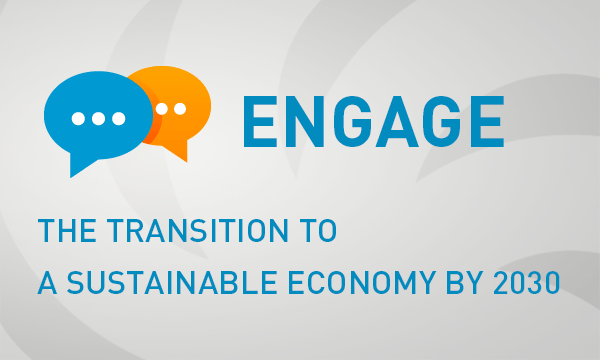Compliance Instrument Trends in the California Cap-and-Trade Program


By Dick Kempka
The California cap-and-trade program recently completed another successful allowance auction, providing an opportunity for lessons learned regarding compliance instruments. The market demand for California Compliance Allowances (CCAs) continues to increase. In turn, the market for offsets (which tend to be less-used) will also continue to grow, providing attractive transaction opportunities for both landowners with potential projects throughout the U.S. and covered entities who are seeking a less costly option to CCAs.
To provide some context, the historic AB 32 California Global Warming Solutions Act of 2006 requires sharp reductions of greenhouse gas (GHG) emissions to approximately 1990 levels by 2020. Covered entities, or sources that emit more than 25,000 tons per year, are required to address their emissions-reduction obligation in three compliance periods: 2013-14 (CP1), 2015-2017 (CP2), and 2018-2020 (CP3). At the end of each compliance period, each facility is required to turn in compliance instruments, including CCAs and a limited number of California Air Resources Board (ARB) offset credits.
In the most recent November 2015 auction, three years after the first auction, all 75.1 million current vintage allowances offered were purchased at an average settlement price of $12.73. This price is 63 cents above the floor price set by ARB. Additionally, all of the 10.4 million future vintage allowances offered also sold out at a price of $12.65. These are positive signs for the California carbon market, and demonstrate that the system is proceeding as planned.
Strong interest from regulated entities around future CCAs are also generating continued interest in offsets. California Carbon Offsets (CCOs) are the first compliance instrument in a covered entities’ portfolio that must be retired. Offsets are generated from sectors that are uncapped in California like forestry, livestock methane and ozone-depleting substances (ODS). ARB has rigorous greenhouse gas accounting protocols for each of these project types that allow quantity and vintage to be determined. Covered entities purchase these credits from individual landowners, project developers, brokers or other sellers.
We believe that the number of covered entities or companies that use offsets in the California system will continue to grow because offsets are less expensive than CCAs. Over the past few years, offsets have traded at approximately 15 to 25 percent below the price of CCAs. The Climate Trust, as well as several other organizations, track price on a weekly (and sometimes daily) basis to inform term sheets used for offset supply and sales contracts.
Of note, under the California Carbon Offsets moniker, three products have emerged:
- CCO8s: These are basic program CCOs with an eight year invalidation period, meaning that the buyer accepts the risk of project or credit invalidation until eight years after initial ARB issuance.
- CCO3s: These are CCO8s where a second verification is conducted that reduces the invalidation period to three years.
- Golden CCOs: GCCOs are CCOs that are backed with a promise to replace with CCAs or cash further reducing buyer risk and giving them premium market value.
There have also been rumors of a potential “Platinum” product that is secured by an insurance offering, similar to a home owner’s insurance policy, but this has yet to be introduced to the market.
Current price for compliance products are listed below:
| COMPLIANCE PRODUCT | PRICE | DISCOUNT TO ALLOWANCE PRICE ($)
|
DISCOUNT TO ALLOWANCE PRICE (%)
|
| CCA (aka allowance) | $12.92 | N/A | N/A |
| Golden CCO (GCCO) | $12.25
|
$0.67 | 5.0% |
| CCO3 | $11.53 | $1.39 | 10.7% |
| CCO8 (CCO or offset) | $11.18 | $1.74 | 13.5% |
A CCA cannot be invalidated, so it is the lowest risk compliance product. Offsets are less costly due to the invalidation risk associated with individual projects, such as a potential federal, state or local environmental law violation at the project site. Offsets are viewed as a cost containment measure by large covered entities, such as oil companies that have the financial wherewithal to manage invalidation risk. Many of the large utility companies are interested in offsets as well, but are more likely to purchase Golden CCOs due to constraints placed on them by the California Public Utility Commission that oversees regulated utilities in the state.
It is likely the California offset supply will be constrained in the long run because there are very few approved project types, and the time to get projects approved is quite lengthy and arduous. For these reasons, a shortage of offset volume is anticipated by many market players, particularly in the latter part of compliance periods 2 and 3. In the meantime, offset volume issuance continues to grow. Forest project offsets were the most rapidly growing project type in the California compliance market in 2015. As of November 25, 2015, ozone depleting substances, livestock, and mine methane capture consists of 12.9M or 38% of ARB Offset Credits Issued. U.S. Forests constitute 21.4 million or 62% of issued offsets, approximately double that of all other project types combined. It is expected that this forestry growth trend will continue in 2016. There are still several early action eligible projects in the queue to be reviewed and potentially approved by ARB staff, which will add a significant number of forestry offsets to the market in 2016.
On November 2, 2015, ARB adopted new Common Practice values for all U.S. Forest Assessment Areas (essentially ecoregions). Over 65 forestry projects were listed as potential ARB compliance projects before this date in order to use the older Common Practice Values, which in many instances are lower and thus more favorable for offset volume generation. This includes over 35 projects with Climate Action Reserve, and over 30 projects with American Carbon Registry. Newly listed projects will increase the offset volume from forestry projects in 2016 as well.
Stabilized and predictable auctions, a growing offset supply, more defined products and a rising CCA and offset price are all great signs the carbon market is here to stay. Entities with emission liability in California and landowners with potential projects should consider building an offset portfolio to take advantage of this supply-constrained market.
Image credit:Flickr/Zoetnet
Dick Kempka is the Chief Commercial Officer for The Climate Trust.
Can Kinetic Energy Help Power Off-Grid Communities?


By Jake Jagdfeld
Resource scarcity is a reality in the world today, and will continue to increase with the growth of the earth’s population and modernization of underdeveloped economies. Specifically, lack of reliable energy and clean drinking water are chief concerns in the developing world. Too often the debate about a solution focuses around major energy projects such as coal and gas-fired power plants, nuclear, or big hydro dams (Big Power). These all come with major political, economic and environmental challenges, and often are not economically feasible for remote or underdeveloped regions.
Typically, developing and remote communities whom are not able to access Big Power are forced to rely on more expensive and unreliable energy, such as diesel power generation, which requires costly shipping in areas that are difficult to reach. These energy sources are too costly for most remote or developing communities. In turn, these communities are often forced to rely on less efficient power sources, such as wood-burning, which requires a great deal man-hours for gathering fuel and in areas where such fuel is frequently scarce. Dependence on these inefficient and environmentally unsound sources of power saps the local community of its ability to engage in other economic and social activities which would improve health and quality of life.
The International Energy Agency calculates that 55 percent of all new electricity supply will need to be furnished through decentralized or off-grid systems in order to provide greater universal energy access. A decentralized and reliable power supply can help developing and remote communities by allowing better social and economic stability and growth potential, which result from access to water purification and pumping, and energy stability for things like schools, healthcare facilities and other economic activities requiring a stable energy supply.
Modern micro-hydro kinetic (MHK) technologies are a potential solution for reliable decentralized energy production in developing and remote communities around the globe by harnessing the kinetic energy of flowing water from the local waterways, and without the major costs associated with Big Power. There are numerous existing technologies intended for producing energy in rivers and ocean currents for such applications, but there has been limited success and adoption of these technologies.
Of previously existing micro hydro technologies in the marketplace today, there are some significant technological limitations. The primary problem with most current “run-of-the-river” hydro technology is clogging and jamming. Many devices were originally designed for wind-power generation, and do not translate well into marine applications. While some devices are efficient at producing energy when operating, they become clogged and jammed by river-debris, which limits or ends their ability to produce energy, and necessitates costly maintenance that may not be feasible in remote or developing regions. This lack of dependability makes adoption of existing micro hydro technology in the developing world slow and difficult, if not wholly impractical.
Verterra Energy is just entering its Series A capital raise to commercially produce its new “run-of-the-river” MHK technology, Volturnus, a hydro-kinetic turbine purpose-built and designed to avoid the clogging and jamming. It has a sleek design for placement on the river-bottom, with low clearance and underwater operation. It is also designed to be environmentally sound and safe for aquatic life. Verterra’s goal is to manufacture Volturnus utilizing recycled materials.
The commercial, 3-meter diameter Volturnus will produce an estimated 10 kilowatt-hours of electricity when placed in waterways with flows of 1.5 to 3 meters per second, which is enough to power seven to 10 average American homes.
Voltunrus can be deployed individually or in “pods” to meet the desired energy production. While costing is not complete, Verterra expects Volturnus will be very competitively priced, with the advantage of avoiding the pitfalls of other MHK technologies.
Early adopters of Volturnus are anticipated to be pilot project developers in Haiti, Tajikistan, Italy and several locations throughout the continental United States. During operation of the pilot projects, Verterra will begin to make Volturnus commercially available, with plans to start deployment in several developing and remote communities around the world for both humanitarian and commercial use.
Additionally, as a part of its commercial and humanitarian development strategy, Verterra is investigating options for deploying Volturnus with other system integration, such as water pumping and purification, and partnering with non-governmental organizations in their humanitarian outreach efforts around the globe.
Image credits: Verterra Energy
Jake Jagdfeld is Communications Director for Verterra Energy, Inc., a renewable energy company based in Minneapolis, Minnesota. [email protected]
Preservatives: The Good, the Bad and the Essential


Preservatives have augmented our favorite foods for thousands of years. Those sugary sweet jams your grandmother may have pulled down from her larder each Christmas or New Year's breakfast, or the canned salted meats that served as a backup for many early American pioneers during seasons when hunting was sparse, are actually some of the later examples of traditional food preservation.
Observant Jews have been using salt to preserve their meats for years. While it is a religious prescription to do so, the act of "koshering," or soaking and heavily salting chicken, lamb or beef prior to use, also serves as 'magic potent' that guards against food spoilage during transport, storage and preparation. Sugar has been used not just as a preservatives in canning, but also as a antimicrobial agent to promote healing in wounds. Both uses gain their popularity from sugar's inhibition of microbial spoilage.
The Korean fermented vegetable dish called kimchi is another example of ancient food preservation at work. The dish, which uses salt and pickling methods for vegetables (often in clay crocks, and traditionally in the ground), has been around since the third century A.D. Kimchi lovers swear by its nutritional and medicinal properties, which are touted to cure constipation and provide balance to the intestinal system. In hot, humid environments across the globe, pickled foods of all kinds serve as an important means for ensuring enough vitamins and fiber in the common diet.
In the last century however, increased food production and changing technology has prompted food producers to search out other ways to guard against food spoilage and extend shelf life. Many of these additives began as natural derivatives that were later engineered as artificial or chemical substances.
Food preservatives: The call for federal regulation
Of course, the concept of using ingredients to artificially retard spoilage in food has not always been popular with consumers. In fact, the push-back against creating artificial, mass-produced preservative compounds has been around just as long as the search for better preservation methods has existed.
The federal Food and Drug Act that now regulates the use of preservatives in the United States owes its origins to just such a backlash in the early 1900s, when the then largely unknown writer, Upton Sinclair, released his book "The Jungle" in 1906. Although Sinclair's story actually had to do with the exploitation of immigrants in food-packing plants (and other industries), it was the unsanitary conditions of those plants and the largely unregulated substances that were being added to food that actually galvanized public outcry. Sinclair's graphically depicted novel not only launched his writing career, but also forced the federal government to recognize the need for further testing and regulation of the preservatives being added to human foods. The Pure Food Act, born out of the populist support for safe and wholesome foods, gave rise to the creation of the FDA as well as the Meat Inspection Act that same year.
While the FDA regulates more than what can be added to the foods we purchase and eat, its oversight has, through the years, prompted acceptance of a wide selection of ingredients that, of their own, aren't meant to add nutritional value to the product. Instead, they serve to artificially bolster the production and shelf life of foods.
But are artificial preservatives always good for us?
The use of artificial preservatives like butylated hydroxyanisole (BHA), nitrates and benzoic acid, which are all used by food manufacturers to slow maturation or spoilage, have been a subject of vigorous debate in past years, particularly as their functions and effects have become better understood.
For example, we now know that nitrate, which naturally occurs in leafy vegetables (and is actually good for us), creates carcinogenic properties when added to red meats. BHA, used in everything from bread to medications, can also be toxic, particularly when ingested in large amounts.
The preservative benzoic acid came into existence when the 16th century seer Nostradamus was working with bitter almonds to produce amygdalin. Today, benzoic acid is synthetically produced. While it is widely used as a preservative, it now falls under the category of suspect additives because of its potential to create benzene when paired with ascorbic acid (Vitamin C).
Few additives can illustrate the confusion over synthetic additives and their risks than Ethylenediaminetetraacetic acid (ETDA), a substance that is often used in chelation, but is also considered a preservative. Its unexpected benefit to food manufacturers comes in its ability to hinder the production of benzene in soft drinks that contain benzoic acid.
21st-century food production: Can we live without preservatives?
New technology has also helped reduce the excess of salt, sugar and honey in foods, which carry with them their own health risks. Products that meet the needs of certain health conditions, such as diabetes and heart disease, continue to add challenge for food producers, who want to appeal to a broader consumer base. So do new processing guidelines that require better separation and identification of allergens such as wheat, milk and nuts, as well as preservatives like malic acid (another natural substance now largely manufactured artificially) that pose health risks for some consumers.
'New' processing techniques like flash freezing and hermetically sealed containers help answer some of these challenges. Foods that can be sealed in hermetic packages or flash frozen without water, sugar or salt can appeal to a broader sector of customers. Irradiation (also called cold pasturization), which is often mistakenly confused with radioactive procedures, helps preserve foods that are susceptible to mold or pests and reduces the needs for expensive product preparation. Hydrogen peroxide, used for years as a food preservative in limited settings, can now be used to safeguard bananas and other fresh fruits and vegetables before they reach the store aisle.
Preservatives will likely always play a role in our food preparation. Expanding global markets and increased demand for food production that can meet the rigor of long distance transport means we must have ways to safeguard the products prior to consumption. But better technology and a better understanding of the chemical interactions in preservatives are natural outcomes of searching for better ways to improve global food security.
Want to try some preservation of your own? Check out the recipe below!
https://www.youtube.com/watch?v=G7qLXrHFMpw
Images: 1) Nic; 2) News21 - National; 3) Yeowatzup; 4) Jeffrey W; 5) Dennis Hamilton; 6) United States Department of Agriculture
Turning (Less) Water into Wine


https://www.youtube.com/watch?v=bzu-bae4EtA#action=share
By Lindsay Bass
In 2014, a small winery in the central coast of California experienced a dramatic reduction in the flow of its groundwater wells, severely limiting the amount of water available for production, and threatening the viability of the entire operation.
At the time, the winery -- along with the rest of California – was experiencing its third straight year of drought. With water resources already scarce, the severe reduction in available water could have been a disaster for the winery, as well as its employees and business partners, many of whom are residents of the surrounding Paicines community. Instead, the winery decided to embark on a new journey of water stewardship.
Although the Blossom Hill Winery was focused on its environmental impact for some time, this was a wake-up call, and sparked a movement to become more organized and prioritize their water stewardship work. World Wildlife Fund (WWF) collaborated on this journey to help Blossom Hill, a property of Diageo Chateau and Estate Wines, become the first winery in the world to pilot elements of the Alliance for Water Stewardship (AWS) Standard.
“For many years, all the way back to 2006, we’ve been monitoring and measuring our water and making improvements,” said Julie Collins, environmental risk manager for Diageo. “But the drought has taken us to a whole new level.”
The AWS framework recognized the previous work Diageo had done on water, but also identified gaps and opportunities where more could be done. Implemented changes ranged from the easy – using brooms to sweep floors instead of washing them with water; switching from 2-inch to 1-inch hoses; reusing the water used to clean tanks to wash floors – to the complex. In the vineyard, for example, Blossom Hill targets water use to the needs of the vine. Sensors in the soil monitor moisture levels. When water is needed, the drip irrigation system is triggered to supply only as much water as the monitors indicate is needed. Therefore, instead of just watering for a set time, increased attention is given to the specific vines in order to determine if it needs water or not.
But one of the most revolutionary changes that Diageo and the winery made – and a key part of the AWS framework – is a culture shift around water. Water efficiency isn’t just a box to tick; it’s become a central focus of the organization. The staff at Blossom Hill created a “Blue Team” consisting of employees from all levels, who meet regularly to discuss water usage, identify problems, and come up with solutions.
“I can focus on saving water but I’m not doing the job every day,” explained Wayne Childress, director of operations at Blossom Hill. “The person who does the job needs to have that focus, and that’s what we’ve tried to change.”
The Blue Team has also created ambassadors who can reach out to the local community about the importance of saving water, working with local farmers and businesses to share success stories and challenges. While this may not be a traditional model of corporate-community outreach, the local, neighborly approach works well in the small agriculture-dominated town. The AWS framework highlights the importance of “talking” along with “doing,” because watersheds can’t be protected by a single user alone, no matter how much work they do inside their fence lines.
The changes Blossom Hill has made around their water usage will continue long after the California drought ends. The winery is using significantly less water while maintaining production levels and high quality standards. They have engaged their community on water, raising awareness amongst the many different people who share the same water source. In times of water crisis, these measures have proven essential.
While the drought in California will certainly end, the experience has taught Blossom Hill and other industries in the area that water is a precious, finite and shared resource, and that it can only be secure if all users work together. Collective action and sustainable management of water by all in the watershed is what will ensure that the winery — and its neighbors — are still thriving 25, 50, or even 100 years from now.
Photo and video courtesy of Blossom Hill Wines
Lindsay Bass is manager of corporate water stewardship for WWF.
Nestlé U.S. Going Cage Free by 2020


The egg industry is often a brutal one, with egg-laying hens hardly living the idyllic life often portrayed on those packages you buy at the supermarket. But the outlook is improving for chickens, due largely to the efforts of the Humane Society. 2015 has been a breakthrough year for the cage-free movement, which has seen companies including Carnival Cruises, Caribou Coffee, Peet’s Coffee, Shake Shack, McDonald’s and Starbucks promise to go cage-free in the next few years. Now add Nestlé’s American operations to the list of companies pledging to reduce animal cruelty within their supply chains.
Last week, Nestlé announced that it will switch to 100 percent cage-free eggs within the U.S. by 2020. The company estimates its annual use of eggs reaching 20 million pounds (9 million kilograms), in products that range from ice cream to frozen dinners to cookie dough. As for its supply chain in Europe and other global regions, the company claims it is working with the NGO World Animal Protection to expand the use of cage-free eggs throughout the rest of its operations.
According to the Humane Society, Nestlé’s transition to cage-free eggs means 780,000 fewer birds will be confined in battery cages annually. That means fewer hens that are denied the ability to act out their natural behavior, which includes dustbathing, nesting and perching. The Humane Society says the averaged caged hen is afforded about 67 square inches (432 square centimeters) of cage space — less room than what can be squeezed within a sheet of letter-sized (or A4) office paper.
It is important to point out, however, that “cage-free” does not necessarily mean cruelty free. As the Humane Society notes, cage-free hens will have more room to move around, but such a label does not guarantee that they spend any time outdoors. Beak cutting is still common practice at many hatcheries. Forced molting, which involves starving hens or feeding them a low-energy diet to manipulate the egg-laying cycle, is also the norm. Furthermore, almost all commercial egg operations kill male chicks shortly after they are hatched — a cruel and wasteful practice that's done because the chickens raised for egg-laying are not as large as the ones used to produce meat.
Nevertheless, the advocacy of organizations, such as the Humane Society, are raising awareness of animal welfare issues, including gestation crates and tail docking. And as more consumers learn about what happens to animals in order to make their food products, they are leaning on companies to change their ways. The result is that firms such as Nestlé really have no choice but to source more responsible ingredients if they are going to keep their customers.
Image credit: David Paul Morris/For the Humane Society
Working Across Silos: License to Fish, License to Build


Editor's Note: To learn more about Bill's thoughts on breaking through silos at your company, check out this post.
By Bill Hatton
One issue in silo-breaking is: Where do you start -- top-down, or bottom-up? Can’t an organization just say, “Share this information" and work together?
Yes, says Silvia Garrigo, a lawyer who has retired as manager of global issues and policy at Chevron Corp.: “There is no doubt that if the CEO or someone on the executive management team tells their function ‘This is the law, abide by it,’ there will be action that will follow that pronouncement; however, in my experience, those kinds of hierarchical decisions and mandates really lead to transactional experiences and results as opposed to the transformational results. I’ve got to go up, down, center, and always deep.”
Garrigo was in charge of creating a human rights policy for Chevron. She says one key was the idea of a “license” to investigate where she needed to, to convene who she needed to convene, and talk to whomever she needed to talk to.
“We had executive champions who said, ‘Silvia, you and your team have an official license, you can go and convene whoever you need to decide if we are going to adopt a human rights policy. What we did – we went out to the field and spoke to seven or eight different business units, chose those which had the most difficult or sensitive operating environments within their day-to-day business, and asked, ‘What are your thoughts on the supply chain, security issues, labor issues’– sometimes mining security is providing by the host government and they have a different concept about how to use power.”
“We went and met all the different functions — procurement, HR, supply chain, functional heads of those units and leadership teams and went deep into their organizations and asked the same questions: ‘What do we already do in human rights and what do we do that touches on human rights that we can leverage on?’ Then we went back to the executive team. They said, ‘Fine, Silvia, your fishing license has now been extended to a construction license. Go back and do more work. Create a policy, an implementation plan and implementation guidance team, and create a governance plan. Who are you going to convene, who are you going to work with and co-create, and what enabling environment are you going to create, and then how are you going to govern all of that?’”
As a result, the team created its policy and its implementation plan, including:
- What to prioritize in the field first and how
- What clear expectations to set under the policy
- What governance to set under that, and
- What review and audit protocols to set, i.e., “If we have a standard, how do we know we’re doing what we say we’re doing, how do we satisfy that standard,” said Garrigo.
Silvia Garrigo spoke at a Nov. 5 Skytop Strategies conference on Integrated Reporting.
Image credit: Flickr/Picturepest
Bill Hatton is a veteran business-to-business writer who has written extensively on CR, EHS, compliance and management topics. He can be reached at billhatton at mountainvieweditor dot com.
Millennials and Other Trends Reshaping America


History will look back at 2015 as a crossroads in America’s adoption of sustainability. It was a year that saw milestone steps toward the adoption of a low-carbon economy with the Clean Power Plan and the COP21 global agreement. The real milestone event of 2015 was California winning world economic growth leadership while also reducing emissions. The first article in this two-part series documented three 2015 mega-trends that are reshaping our country's trajectory toward human health, environmental and economic sustainability.
This second article profiles the 2015 milestone steps created by the millennial generation, our national weight crisis and corporate social responsibility's growing role in determining business success that are now the driving forces behind the emerging $250 trillion green economic revolution.
Millennials emerge as the driving force for the green economic revolution
2015 marked the milestone emergence of the millennial generation as the driving force behind the green economic revolution. Their demand for more sustainable products is reshaping commerce where software is sold as a service, products are shared and a green supply chain is a marketing necessity. Millennials, along with moms, are using their buying power to reshape the food industry around sustainably-sourced, clean food.
A 2015 millennial milestone event was this generation's new position as the United States' largest employed demographic group. Research released during 2015 found that millennials, unlike any other generation, expect CSR to be part of their job. This expectation is pushing commercial real estate's adoption of smart building designs using collaborative workspace along with increased investments in onsite solar systems, energy efficiency and smart building technologies.
By 2017 the millennial generation will be both our country's most employed demographic group and our country's largest consumer group. Future business success now hinges on satisfying the millennial generation's sustainability expectations.
National weight crisis
2015 provided further documentation that, for the first time in history, our health is threatened by our weight. We are in a national weight crisis. No generation is immune. Seventy-two percent of baby boomer men and 67 percent of this generation’s women are overweight or obese. It is now projected that 50 percent of Generation Z, the first generation born into the 21st Century, will be obese during their lifetime.
Encouragingly, 2015 saw a milestone where Costco became America’s largest retailer of organic food. Healthier food sales are now growing at three times the sales growth rate of less healthy food. Consumers are increasingly leaving the grocery store center aisles and fast food drive-through windows in search of foods that are labeled clean, organic, gluten-free and sustainably sourced.
Even so, a new lifestyle paradigm is required. Similar to the consumer search for sustainable products, we are in a national search for how to have fun while doing right by our health and the environment.
Growing link between CSR and business success
In 2015 Nielsen released research that found 66 percent of surveyed consumers say they will pay more for products and services that come from companies that are committed to positive social and environmental impact. The business bottom line is that adopting corporate social responsibility (CSR) is the path to growing sales without damaging price competition.
2015 was a watershed in how businesses compete. A business can buy customers with price discounts. They can win customers by selling highly authentic products that are produced and delivered through transparent business practices. In 2015 corporate social responsibility moved from its historical niche role to become a driver in how businesses win and retain customers, most especially during today's intense price competition.
2015 accelerated the path along the green economic revolution
The following six 2015 mega trends accelerated the adoption of the Green Economic Revolution that delivers goods and services costing less and delivering more as measured in human health, environmental protection and economic growth:
Low-carbon economy. 2015 saw the achievement of economic growth and reduced emissions. California has turned global warming into an economic growth engine driving its economic success by delivering low emissions technologies that are price competitive with fossil fuels. California' success, along with the launch of the Clean Power Plan and the COP21 agreement, gave birth in 2015 to the low carbon carbon economy.
Solar price-competitiveness. 2015 saw solar power gain price competitiveness with fossil fuel generation. 2015 was also the year battery technologies began their path toward price competitiveness through increased economies of scale. 2015 was a launch year for an energy future where renewable energy and batteries will be the core technologies for our buildings and cars.
Cities default to green. Cities cannot wait any longer for national governments to adopt sustainable public policy. As a result, city leaders around the world are aggressively innovating in search of sustainable solutions to pollution, congestion and food porn. Their path toward "defaulting to green" is now a global innovation engine driving adoption of sustainable technologies and public policy.
Millennials drive the green economic revolution. The millennial generation is displacing the baby boomer generation in terms of employment and buying power. This mega shift is driving a green economic revolution. Today, businesses must incorporate CSR into job tasks to successfully recruitment millennials. Going forward, millennials will push CSR from a niche staff function to a core product design attribute.
National weight crisis. Food is increasingly becoming the path for initial consumer adoption of sustainable best practices. Industrial foods taste great, cost less and are the basis for a weight crisis that has delivered a diabetes epidemic and soaring health care costs. This ticking time bomb is exploding and only consumer purchases of clean and sustainably sourced foods will prevent a devastating denotation.
CSR is now core to business success. 2015 provided the evidence that CSR wins customers. It is the path out of the margin destroying price competition that continues to depress our economy. Companies like Unilever get it and are growing revenues and profits by incorporating CSR best practices in product designs and business operations. 2015 leaves us with the question of how quickly the majority of businesses will see CSR as the marketing path to winning and retaining customers.
Image credit: Pixabay
Enter Masdar’s 2016 'Engage' Blogging Contest! The Transition to a Sustainable Economy by 2030


You could be honored as Masdar's guest VIP blogger and win an all-expense-paid trip to Abu Dhabi Sustainability Week in mid-January, 2016. Enter Masdar's Engage blogging contest, and write a response to this prompt: Describe how government and businesses can cooperate to build a sustainable economy.
Businesses look for governments to implement policies that can provide a framework and guarantee economic stability, so that the private sector can plan for the long term.
- Should governments issue more regulations in order to secure a more sustainable future? Must financial incentives be available in order for next-generation technologies to thrive?
- Do we need programs that foster innovation and encourage more research and development, which, in the long run, can help solve future risks posed by climate change?
- Or should there be a more laissez-faire approach, as it is up to businesses to adapt to changing circumstances?
Be creative! The aforementioned topics are just a few examples of ideas that could provide solutions for climate change over the next 15 years. There is not a “right answer,” but the best response to this year’s question is one that offers a well-reasoned and logical approach for what almost everyone agrees is one of this century’s most pressing challenges.
The winning entry will clearly describe how government and business can cooperate in order to allow current and future solutions for climate change to scale and succeed, and therefore, play a significant role in limiting the increase in global temperatures to 2 degrees Celsius by 2030.
Guidelines to writing the winning post:
The scientific community in general believes that increases in global temperatures must be limited to 2 degrees Celsius in order to mitigate the risks that could result from climate change. While governments and international organizations have long been at the vanguard of finding solutions for climate change, recent trends have shown that the global business community has become more vocal and proactive about the need to shift toward a sustainable economy by 2030.
Masdar’s 2016 blogging contest is all about how business can cooperate with government on addressing climate change and help society transition to a sustainable economy within the next 15 years.
See last year's winning entry here.
Visit Masdar's site for more info and terms of the contest.
Entries are due January 4th!
We hope to see YOUR post in the competition! Good luck!
The Best Job in the World?


Let me start out by saying that I have a pretty awesome job: the kind of job that lets me learn new things every day, impact causes I care about and even get paid to hike in Peru. But the local guides who lead curious travelers along those cliffside trails through ancient ruins may just have me beat.
In Peru, tourism is a historic and lauded career path. As Ernesto Ore, lead guide for REI Adventures' Sacred Valley tours, pointed out: Tour guides have worked in Peru since Incan and pre-Incan times, and children learn about the profession as early as elementary school.
Locals must attend college for five years to gain certification to work as a guide. They're required to learn one foreign language, usually English. But many, like Ore, choose to learn more (he speaks five languages, including English, German and Italian).
Most guides work on a quasi freelance basis, often contracting their services out to several local tour operators. For responsible travel companies based outside of the country, arguably the only way to go is to partner with one of these in-country operators, as this ensures tourism dollars reach the local economy. REI Adventures takes things a step further by partnering with local operators, then hand-picking guides who have a love for outdoor adventure.
Ore, one of 318 local guides REI partners with around the world, said he first decided to become a tour guide in primary school. At a cafe in Cusco, I asked him if his career path was all he expected it to be. "It's actually more than I expected," he replied with a smile. "Being a local ambassador for visitors, it's a nice feeling."
Like many REI guides, Ore has a long history with the company. For 10 years, he's trekked the Sacred Valley and Machu Picchu with around eight REI tour groups a year, but he says it never gets old. "I'm happy to share my culture," he told me, "and I think I have the best job in the world."
Making outdoor careers possible
REI Adventures is selective about its partners, focusing on operators that emphasize ecotourism and the outdoors. "We really seek out companies and guides that align with REI's values, and it makes a big difference in the experience," Cynthia Dunbar, general manager of REI Adventures, told TriplePundit. "We have a long-term philosophy around really working with people who live in, love and know the places we visit like the back of their hands."
In turn, guides say the outdoor company is open to advice and feedback to further improve the experience for travelers. "We can recommend something and make suggestions," said Marco Serrano, an assistant guide for REI Adventures' Sacred Valley tours. "And they will listen."
Serrano, 25, is fairly new to the biz and has only been guiding for two years. But he told me he's already hooked, adding that the career allows him to "work outdoors" and "show people the culture" -- two things he loves to do.
This is really what it's all about, Dunbar told 3p: "helping build community, whether it's through your professional career path, whether it's your passion in the outdoors, whether it's supporting the outdoor community through our nonprofit, [REI] is really committed to all the ways that people can get outside and supporting them in a positive way."
"I can't say the number of times I've been with guides and they just look and me, smile, turn around and say, 'How do you like my office?' And you're looking at this beautiful mountain or vineyard or wherever you happen to be hiking, biking or climbing. It's pretty cool."
Full-scale employee engagement
Every year, REI calls on its field partners, along with employees, co-op members and customers who have taken an REI Adventures trip, to nominate their top local guides of the year. Using a rating system that weighs customer reviews, seniority and other factors, the company then selects five to seven guides for the year's top brass -- which carries a host of awesome perks along with bragging rights. Dunbar and Ore, who was voted a top guide in 2014, explained further.
Top guides are flown to REI's headquarters in Seattle, where they meet with company executives and, of course, get outside for outdoor activities in the area (Ore's highlight was a hike on Mount Rainier). REI rents a house so all of the guides can stay together, and helps them secure visas and travel documents if necessary. Each guide also receives a gift card and employee discount to shop at the outdoor gear company's Seattle store. The trip culminates with a celebration at REI's flagship store, where execs present guides with their awards in front of a crowd of co-op members and loyal REI customers.
Although these hardworking men and women spend their lives showing travelers their hometowns, many don't have the cash or spare time to travel themselves, especially to the U.S., Dunbar told 3p. "For several of them, it's their first time out of their home country."
While it may seem simple to some, REI Adventures' interactions with its in-country guides represent a case study in full-scale employee engagement. While engagement within a company's own four walls is now a must-have, most firms don't bother to think about contractors and other stakeholders. Forward-thinking companies, both inside and outside of the travel industry, would likely do well to take notice and consider what they can do to engage and reward employees and contractors all the way down the supply chain in 2016.
Image credit: Mary Mazzoni
2015 in Review: The Sustainability Mega-Trends Driving Business Success


There was much to be pessimistic about in 2015 in terms of people, planet and business success. 2015 generated further documentation that the world is hot and is getting hotter. It also generated increased evidence of our national, and now international, obesity and diabetes epidemic. Seven years after the Great Recession, our national and world economies are still struggling to achieve sustained growth. The numbers suggest it will be hard to be optimistic about 2016 based on 2015.
However, 2015 did see milestone events that advanced sustainable solutions. It provided additional confirmation that the green economic revolution is real and growing even if the word 'green' may be fading in use as a description for triple-bottom-line results. 2015 was a milestone year for growth in economies of scale for renewable energy technologies that will enable a low-carbon world. It saw consumers buying record volumes of clean food to address their fears over food safety and health. Based on this evidence, I now project that $250 trillion of investment and commerce will occur during the 21st century that will reshape the world’s trajectory toward economic, human health and environmental sustainability.
This article is the first of a two-part series. This first article focuses on the birth of the low-carbon economy, solar energy’s milestone price-competitiveness and the emergence of cities as sustainability pioneers. The second article focuses on how millennials, our national weight crisis and corporate social responsibility (CSR) is reshaping, and greening, our economy.
The birth of the low-carbon economy
In 2015, the concept of a low-carbon economy achieved milestone acceptance levels among businesses and governments. The COP21 agreement established a working framework for the development of a global low-carbon economy. COP21’s economic challenge, and opportunity, will be whether a global price for carbon emerges at the world’s pump, meter and cash register.
What may be the larger 2015 low-carbon economy milestone is the success California has had in decoupling emissions and economic growth. California’s economic growth is the envy of the nation and the world. California is the headquarters for the companies that are reshaping the world including Google, Apple, Disney and Amgen (Applied Molecular Genetics). As significantly, California set a 21st-century milestone by achieving leadership economic growth while also reducing emissions.
The emerging path toward a low-carbon economy was also confirmed by the International Energy Agency. It reported that, for the first time in modern history, the world achieved economic growth while also reducing greenhouse emissions. It may be that the world will look back at 2014-15 as the end of the Industrial Age and the birth of the low-carbon economy.
Cities
Cities are where most of us live. They have also become the 21st-century battleground for mankind’s adoption of sustainability. City mayors and their staff no longer have the luxury of debating climate science. Unfortunately, Beijing is now the poster child of a city that is suffering economic loss and a human health crisis as a result of unsustainable decisions to rely on coal-fired power plants and vehicles running on fossil fuels.
2015 also saw cities around the world invent sustainable best practices to improve human health and grow their economies. An emerging trend that surfaced in 2015 was a default-to-green public policy. Default-to-green turns traditional public policy of accepting the lowest bid on its ear with public policy that makes sustainable procurement the supply choice. Less sustainable supply choices can only be procured through written justification and special approval.
Solar wins on price!
Solar price competitiveness was the renewable energy story of 2015. In Texas, the prices submitted to the city of Austin’s renewable energy RFP shocked the electric utility industry. The average solar bid price was 4 cents per kilowatt-hour. There were bids priced even lower than this average. Even with natural gas prices hovering around $2 per MMBTU, the price for zero emissions solar is a disruptive force reshaping the electric utility industry.
The 2015 Clean Power Act will further accelerate the electric utility industry’s shift away from coal. This act mandates utility reductions in carbon emissions by 32 percent by 2030. Low solar and wind power prices along with increased environmental regulations are pushing utilities to reconsider their traditional solution of displacing coal with natural gas. 2015 saw progressive utilities actively reconceptualizing their grids to displace both coal and natural gas with a combination of wind/solar energy plus battery storage.
However, the electric utility industry’s path toward sustainability was not all positive. The electric utility industry had milestone success in 2015 protecting their revenues against customer-owned solar. 2015 saw utility after utility successfully convince their regulatory bodies to limit, undermine or block net-metering economics. The rate redesigns won by the utilities have eroded the economics of customer-owned solar through higher fix charges, lower payments for solar energy and increased pricing complexity. This has made it more difficult, or even unlikely, for customers to successfully figure out the economics of investing in solar for their homes or businesses.
However, in jurisdictions like California where the regulatory commission confirmed net metering, customer-owned solar is changing consumer behaviors. Customers with their own solar system are increasingly leasing electric cars -- using the savings from their utility bills to pay for the leases and lower solar electricity costs to save at the pump. This growing class of solar customers are dramatically lowering their carbon footprint to achieve equally dramatically lower costs.
How millennials and our national weight crisis is shaping business success
What emerged during 2015 was the growing role that millennials, our national weigh crisis and CSR is having on a business' ability to win customers and retain work associates. The second part of this two-part article focuses on these three 2015 mega-trends that are changing the path to business success.
Image credit: Pixabay